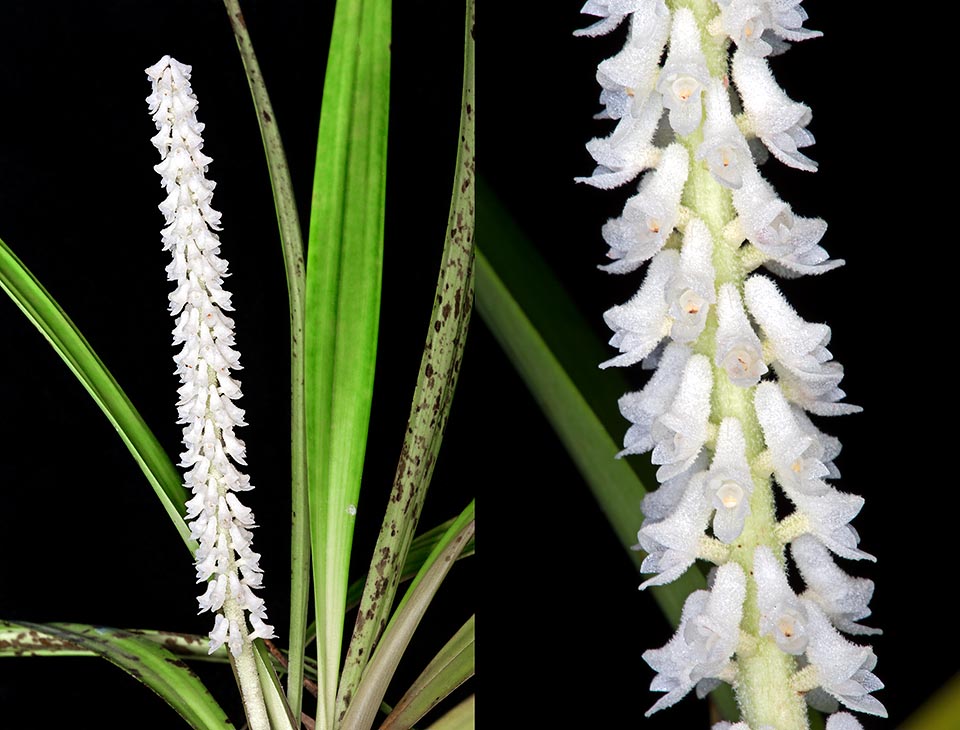Family : Orchidaceae

Text © Pietro Puccio

English translation by Mario Beltramini
The species is native to Borneo, Peninsular Malaysia, Sumatra and Thainland where it grows on the trees of the evergreen humid forests or on rocks covered by moss between 1200 and 2000 m of altitude.
The generic name is the combination of the Greek substantives “ἀσκίδιον” (askidion) = small pouch and “ἔριον” (erion) = wool, with reference to the tomentose saccate labellum; the specific name is the combination of the Latin adjective “longus, a, um” = long, and of the substantive “folium, i” = leaf, with obvious reference.
The Ascidieria longifolia (Hook.f.) Seidenf. (1984) is an epiphytic or lithophytic species with close pseudobulbs, cylindrical, 10-25 cm long and of about 0,5 cm of diameter, slightly enlarged at the base and covered by pointed sheaths, 7-10 cm long the lower ones, 10-15 cm the upper, provided of 2-3 linear leaves with pointed apex, 20-35 cm long and 1-2 cm broad. Terminal inflorescences, 10-20 cm long, bearing several tight sessile flowers, spirally arranged on the rachis, white, tomentose, of about 3 mm of diameter, not resupinate (with the labellum up, over the column), with oblong dorsal sepal, ovate lateral sepals, oblong petals and saccate labellum.

Rare in cultivation, Ascidieria longifolia is an epiphyte or lithopyte. Close pseudobulbs, cylindrical, 10-25 cm long and 0,5 cm broad. Native to Borneo, Peninsular Malaysia, Sumatra and Thailand, has 10-20 cm terminal inflorescences with several white sessile flowers of 3 mm of diameter, tomentose, tight and spirally arranged on the rachis © Giuseppe Mazza
It reproduces by seed, in vitro, and at amateurish level, by division with each section provided of at least 3-4 pseudobulbs.
Species rare in cultivation, present only in the botanic gardens and in specialized collections, requires a semi-shady exposition, medium temperatures, 18-28 °C, high humidity, 70-85%, and constant ventilation. Regular and abundant waterings during the growth, slightly more reduced during the vegetative stasis, utilizing rain water, demineralized or by reverse osmosis. It is usually cultivated in pots or baskets with aerated and draining compost that can be formed by bark fragments and medium sliced charcoal with addition of moss to maintain the humidity. The repottings are to be done at the vegetative restart when the compost gives signs of deterioration.
The species is reported in the appendix II of CITES (species whose trade is internationally ruled).
Synonyms: Eria longifolia Hook.f. (1890); Pinalia longifolia (Hook.f.) Kuntze (1891); Eria verticillaris Kraenzl. (1910); Cymboglossum longifolium (Hook. f.) Brieger (1981); Ascidieria verticillaris (Kraenzl.) Garay (1995).
→ For general notions about ORCHIDACEAE please click here.
